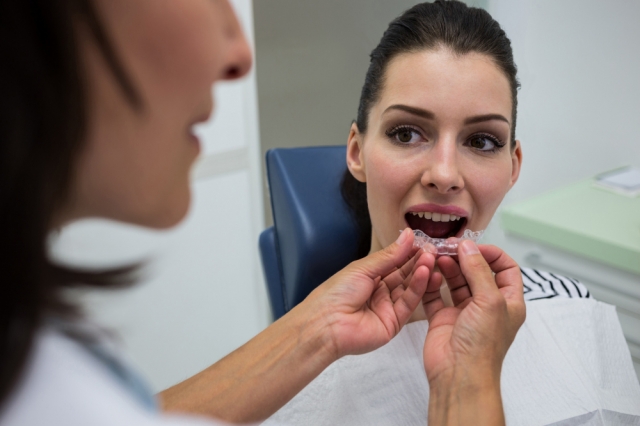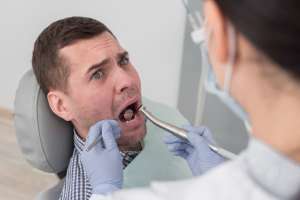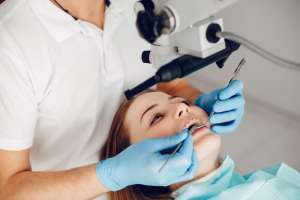Thinking about straightening your smile with clear aligners—but already have crowns, implants, or bridges in place? You're not alone. Many adults exploring orthodontic treatment bring with them a dental history that includes restorative work. And while aligners are a great option for many, it's important to understand how existing dental restorations can shape your treatment plan.
In this guide, we'll walk you through what moves and what doesn't, how your timeline might differ, and what you'll want to ask at your first consult. Here's what we'll cover:
- How crowns and implants behave differently during aligner treatment
- What treatment typically involves when implants or bridges are present
- How your age and restoration type may influence your timeline
- Tips to keep your dental work clean and stable during treatment
- What to bring and ask during a consultation
Crowns and implants affect aligner planning differently
Crowns and implants serve very different roles in the mouth—and that matters when it comes to orthodontics. Crowns are caps placed over a tooth, often to protect it after a root canal or restore a damaged tooth. Implants, on the other hand, are anchored into the jawbone and act as permanent replacements for missing teeth.
Because implants are fixed into the bone, they can't be moved by aligners. Crowns, however, can often move with the tooth—provided they're in good condition and the forces applied are gentle and well-planned.
When an orthodontist evaluates your smile, they'll map out movement paths that work around your implant. Bridges, which span multiple teeth, can complicate things further if they link teeth that need to move independently.
Materials matter here, too. The interaction between aligners and restorations often depends on what your crowns or implants are made of, as outlined in this dental implant materials overview.
Aligners move natural teeth around fixed implants and bridges
The key to successful treatment with restorations is precise planning. Since your implant is anchored in place, your provider will focus on moving natural teeth adjacent to it. Clear aligners work by applying targeted pressure, and with smart staging, they can nudge your natural teeth into better positions while leaving your implant untouched.
Attachments—those small, tooth-coloured bumps—are often used to help guide and grip the aligner. These are typically placed on your natural teeth, not on the implant.
When implants or crowns are involved, the treatment strategy may shift slightly. This guide to clear aligners with crowns or implants explains how dentists customise plans for these cases and what kinds of outcomes to expect.
Because each case is unique, your provider may recommend a more limited treatment goal—such as straightening front teeth—especially if several implants or bridges are involved.
Timelines and limits differ for adult orthodontics
Your treatment timeline isn't just about how many teeth need to move—it also depends on how they move, your bone's responsiveness, and how well you stick to your wear schedule.
Adults often take longer than teens to complete aligner treatment, in part due to slower bone remodeling and the presence of restorations. If you've had restorative dental work over the years, the dentist will also consider how those materials and positions affect the force paths.
The American Association of Orthodontists notes that adult cases are more varied and tend to require more careful planning, especially when dental work is in play. Appliance type, movement limits, and retention strategy all factor in.
Here are a few factors that influence your timeline:
- Number of teeth requiring movement
- Whether bite changes are needed
- Age and bone health
- Presence of bridges or implants
- Consistency with wearing aligners
Crowns may change attachments and aligner grip
Attachments help aligners grip and move the teeth—acting like handles to guide specific motion. When a crown is involved, the material (such as porcelain or zirconia) may impact how well these attachments bond.
In many cases, the provider may choose to place attachments on neighbouring natural teeth instead of directly on a crown. The fit of the aligner may also be slightly different over crowned teeth, so in-person fit checks are especially important.
As explained in this FDA consumer update on braces and aligners, aligners are medical devices that should be used under dental supervision. Even subtle variations in crown shape or bonding material can change how your aligners seat and perform.
Here's a quick fit check list:
- Do the trays fully seat over all teeth?
- Are there gaps near the crown edge?
- Is the tray rocking or shifting when biting?
Hygiene and maintenance matter more with restorations
When you're wearing aligners, oral hygiene is always important—but if you've got crowns or implants, it's even more critical. Bacteria can build up around the edges of restorations or at the gumline, potentially leading to decay or inflammation.
Daily habits like brushing twice, flossing with aids (such as floss threaders or water flossers), and cleaning your aligners each time you remove them make a real difference. This is especially true for older adults, where dry mouth or manual dexterity changes can affect cleaning routines.
These oral health tips for senior adults include useful reminders and tools that are well-suited for aligner wearers with restorations.
It's also smart to time professional cleanings with tray changes when possible. The NIH's implant care overview provides more context on maintaining peri-implant tissue health and monitoring for inflammation.
At-home hygiene checklist:
- Clean aligners morning and night
- Use fluoride toothpaste
- Clean between teeth daily
- Soak aligners weekly (as advised)
- Avoid sugary or staining drinks while trays are in
Your first consult and ongoing oversight reduce risks
Dental history matters—so be ready to share details about crowns, implants, root canals, or bridges at your initial consultation. X-rays and dental records help, but even a written summary of your work can guide planning.
One important point: steer clear of mail-order or unsupervised aligner systems. The AAO's guide to at-home orthodontics highlights the risks of attempting tooth movement without professional oversight, especially when restorations are involved.
A few good questions to ask at your consult:
- Can you move the teeth around my implant?
- Will attachments be used on crowns?
- How long will my treatment take?
- How often should I come in for fit checks?
- What's the hygiene plan during treatment?
- How will retainers fit after aligners are done?
Wrap-up and next steps
In short: clear aligners move natural teeth, but implants stay put—and crowns need some finesse. With the right planning, you can still improve your smile even with past dental work. Just remember that timelines may vary, hygiene routines are essential, and face-to-face supervision can make all the difference.
Whether you're newly curious or actively consulting, make a list of your restorations, gather your questions, and talk with a licensed provider about what's possible.






